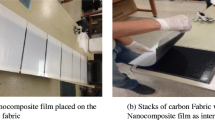Abstract
Carbon fiber reinforced composite has gained a huge popularity as a protective material against impact loading due to its excellent properties such as light weight, high specific strength and high specific modulus. Determining perforation characteristics of fiber reinforced composite laminates is an integral part for the design of protective civil and military structures. In this work, the perforation characteristics (ballistic limit, residual velocity, perforation energy) of carbon fiber reinforced polymer (CFRP) laminates were determined with the help of experimental tests and numerical simulations. CFRP laminates with four different fiber orientations, each of two different thicknesses (1 and 2 mm) were considered in this study. These laminates were impacted by conical, hemispherical and ogive nose projectiles made of steel for a wide range of velocities. The high velocity impact experiments were carried out using pneumatic gun setup. A numerical model was developed in ABAQUS/EXPLICIT using Hashin damage criteria to understand the perforation behavior of CFRP sheets under high velocity impact. The accuracy of the numerical model was assessed by comparing its prediction with experimental results of cross-ply laminates. The perforation characteristics predicted with the help of numerical simulations were in good agreement with the experimental test results. Effective ply configuration was achieved in terms of energy absorption and damage resistance for better performance under impact loading. The influence of shape of the projectile, ply orientation, thickness at different impact velocities on energy absorbing capacity of CFRP laminates were discussed.
Access this chapter
Tax calculation will be finalised at checkout
Purchases are for personal use only
Similar content being viewed by others
References
Balaganesan G, Velmurugan R, Srinivasan M, Gupta NK, Kanny KJIJIE (2014) Energy absorption and ballistic limit of nanocomposite laminates subjected to impact loading. Int J Impact Eng 74:57–66
Pandya KS, Dharmane L, Pothnis JR, Ravikumar G, Naik NK (2012) Stress wave attenuation in composites during ballistic impact. Polym Testing 31(2):261–266
Dutta PK, Farrell D, Taylor S, Tadayon A, Hui D (1996) Ballistic perforation of graphite/epoxy composite, Special report 96–29. US Army Corps of Engineers
Cantwell WJ, Morton J (1989) The influence of varying projectile mass on the impact response of CFRP. Compos Struct 13(2):101–114
Cantwell WJ, Morton J (1990) Impact perforation of carbon fibre reinforced plastic. Compos Sci Technol 38(2):119–141
Pernas-Sánchez J, Artero-Guerrero JA, Viñuela JZ, Varas D, López-Puente J (2014) Numerical analysis of high velocity impacts on unidirectional laminates. Compos Struct 107:629–634
Guoqi Z, Goldsmith W, Dharan CKH (1992) Penetration of laminated Kevlar by projectiles—II. Analytical model. Int J Solids Struct 29(4):421–436
Mines RAW, Worrall CM, Gibson AG (1998) Low velocity perforation behaviour of polymer composite sandwich panels. Int J Impact Eng 21(10):855–879
Fuoss E, Straznicky PV, Poon C (1998) Effects of stacking sequence on the impact resistance in composite laminates—part 1: parametric study. Compos Struct 41(1):67–77
Hitchen SA, Kemp RMJ (1995) The effect of stacking sequence on impact damage in a carbon fibre/epoxy composite. Composites 26(3):207–214
Lopes CS, Seresta O, Coquet Y, Gürdal Z, Camanho PP, Thuis B (2009) Low-velocity impact damage on dispersed stacking sequence laminates. Part I: Experiments. Compos Sci Technol 69(7–8):926–936
Dorey G (1975) Failure mode of composite materials with organic matrices and their consequences in design. In: AGARD conference proceedings
Velmurugan R, Naresh K, Shankar K (2018) Influence of fibre orientation and thickness on the response of CFRP composites subjected to high velocity impact loading. Adv Mater Process Technol 4(1):120–131
Guoqi Z, Goldsmith W, Dharan CH (1992) Penetration of laminated Kevlar by projectiles—I. Experimental investigation. Int J Solids Struct 29(4):399–420
Shi Y, Swait T, Soutis C (2012) Modelling damage evolution in composite laminates subjected to low velocity impact. Compos Struct 94(9):2902–2913
Corran RSJ, Shadbolt PJ, Ruiz C (1983) Impact loading of plates—an experimental investigation. Int J Impact Eng 1(1):3–22
Radin J, Goldsmith W (1988) Normal projectile penetration and perforation of layered targets. Int J Impact Eng 7(2):229–259
Hashin Z (1980) Failure criteria for unidirectional fiber composites
Abaqus V (2014) 6.14-1. Abaqus/standard user’s manual and Abaqus CAE manual. Providence, RI, USA: Dassault Systemes Simulia Corp
Barbero EJ (2013) Finite element analysis of composite materials using AbaqusTM. CRC press
Author information
Authors and Affiliations
Corresponding author
Editor information
Editors and Affiliations
Rights and permissions
Copyright information
© 2022 The Author(s), under exclusive license to Springer Nature Switzerland AG
About this paper
Cite this paper
Patnaik, G., Kaushik, A., Rajput, A., Prakash, G. (2022). Numerical Study on Perforation Characteristics of Carbon-Fiber Reinforced Composite Laminates Subjected to Impact Loading. In: Marano, G.C., Ray Chaudhuri, S., Unni Kartha, G., Kavitha, P.E., Prasad, R., Achison, R.J. (eds) Proceedings of SECON’21. SECON 2021. Lecture Notes in Civil Engineering, vol 171. Springer, Cham. https://doi.org/10.1007/978-3-030-80312-4_21
Download citation
DOI: https://doi.org/10.1007/978-3-030-80312-4_21
Published:
Publisher Name: Springer, Cham
Print ISBN: 978-3-030-80311-7
Online ISBN: 978-3-030-80312-4
eBook Packages: EngineeringEngineering (R0)




